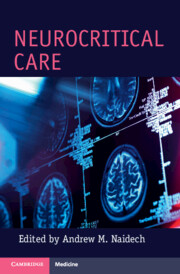Book contents
- Neurocritical Care
- Neurocritical Care
- Copyright page
- Contents
- Contributors
- 1 Introduction
- 2 Intracranial Pressure Monitoring and Management
- 3 Disorders of Temperature Regulation
- 4 Approach to Neuroimaging of the Brain, Vessels, and Cerebral Edema
- 5 Airway and Ventilator Management of the Neurologically Critically Ill Patient
- 6 Neurocritical Care Pharmacology
- 7 Intracerebral Hemorrhage
- 8 Correction of Coagulopathy
- 9 Subarachnoid Hemorrhage
- 10 Subdural Hematoma
- 11 Critical Care Management of Neurotrauma
- 12 Critical Care Management before and after Open and Intravascular Procedures
- 13 Shared Decision-Making in the Neuro-ICU
- 14 Status Epilepticus and EEG Monitoring
- 15 Evaluation of the Comatose Patient and Overview of the Brain Death Examination
- Index
- References
10 - Subdural Hematoma
Published online by Cambridge University Press: 19 May 2022
- Neurocritical Care
- Neurocritical Care
- Copyright page
- Contents
- Contributors
- 1 Introduction
- 2 Intracranial Pressure Monitoring and Management
- 3 Disorders of Temperature Regulation
- 4 Approach to Neuroimaging of the Brain, Vessels, and Cerebral Edema
- 5 Airway and Ventilator Management of the Neurologically Critically Ill Patient
- 6 Neurocritical Care Pharmacology
- 7 Intracerebral Hemorrhage
- 8 Correction of Coagulopathy
- 9 Subarachnoid Hemorrhage
- 10 Subdural Hematoma
- 11 Critical Care Management of Neurotrauma
- 12 Critical Care Management before and after Open and Intravascular Procedures
- 13 Shared Decision-Making in the Neuro-ICU
- 14 Status Epilepticus and EEG Monitoring
- 15 Evaluation of the Comatose Patient and Overview of the Brain Death Examination
- Index
- References
Summary
Subdural hematoma (SDH) is the most common form of traumatic intracranial hemorrhage. SDH occurs in the potential space between the dura and arachnoid membranes. Initial presentation ranges from asymptomatic to coma, with subacute and chronic SDH often having more insidious presentations. Diagnosis is most commonly via non-contrast head CT scan. Treatment includes surgical drainage, reversal of anticoagulation, and supportive care.
- Type
- Chapter
- Information
- Neurocritical Care , pp. 184 - 195Publisher: Cambridge University PressPrint publication year: 2022



